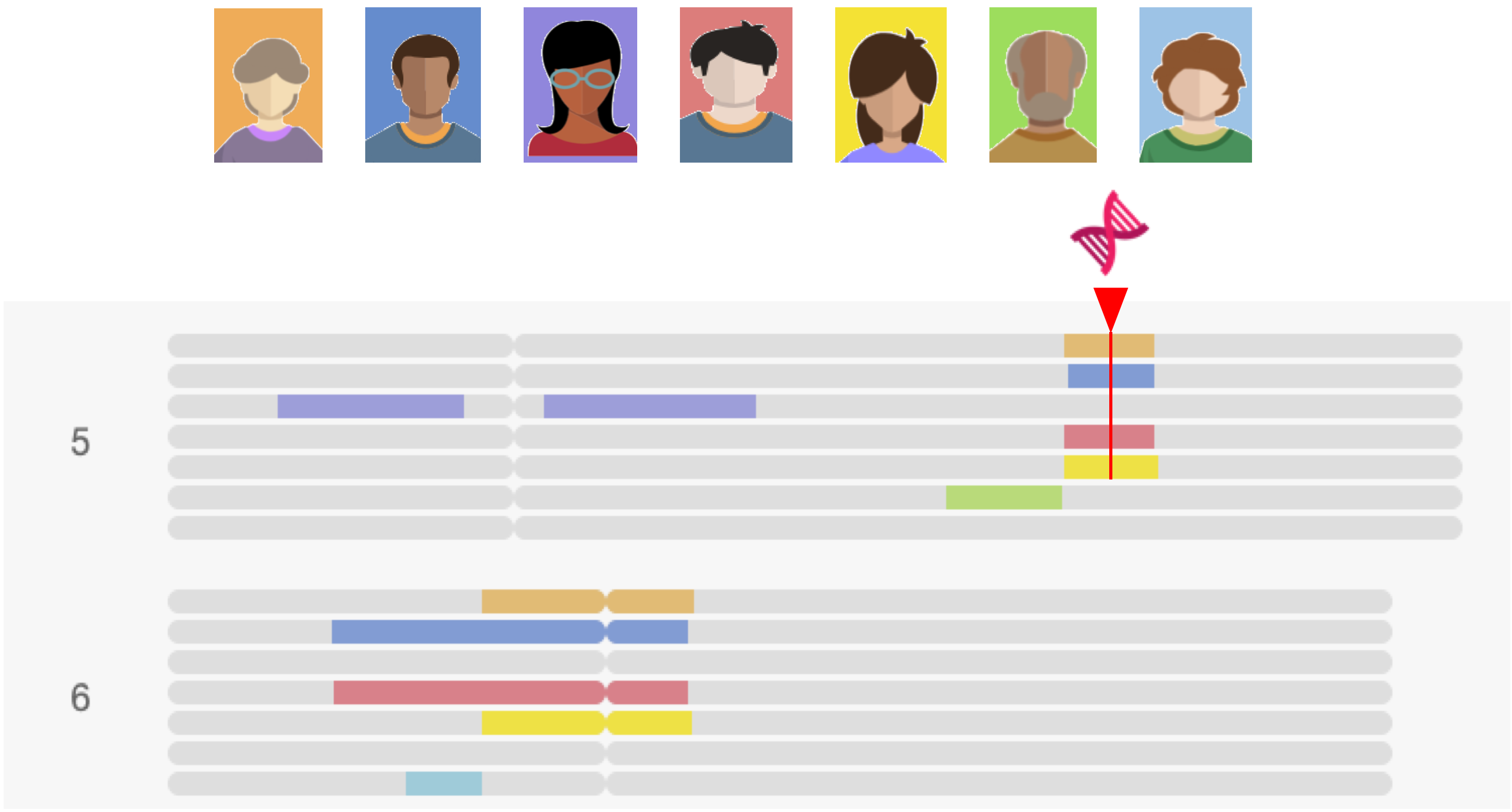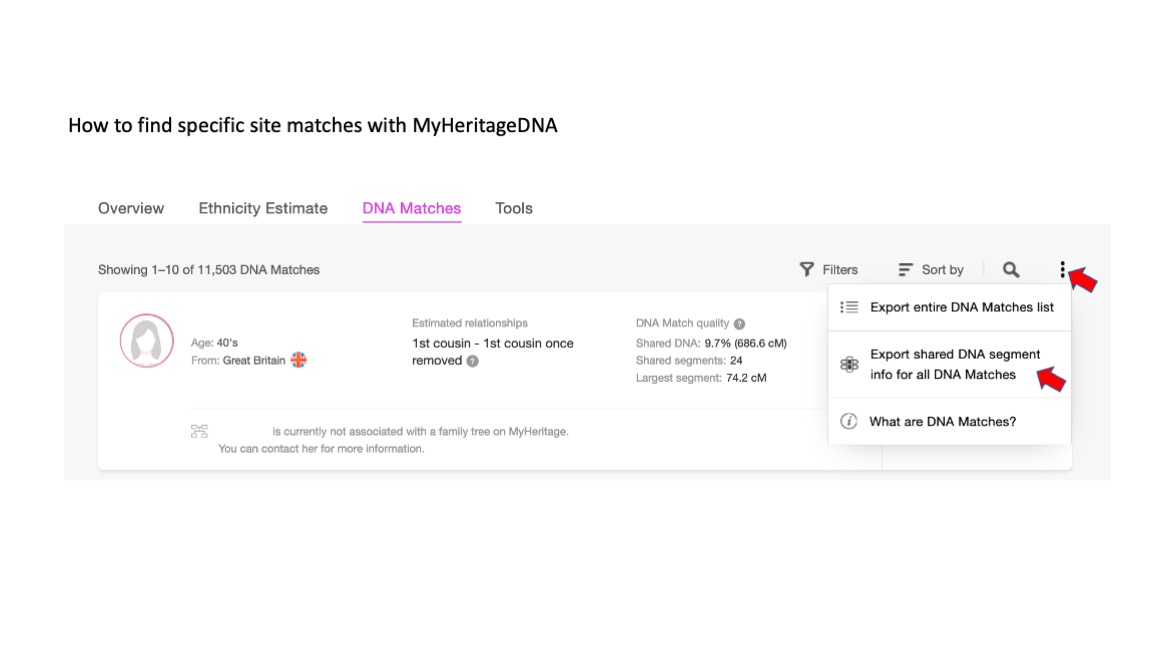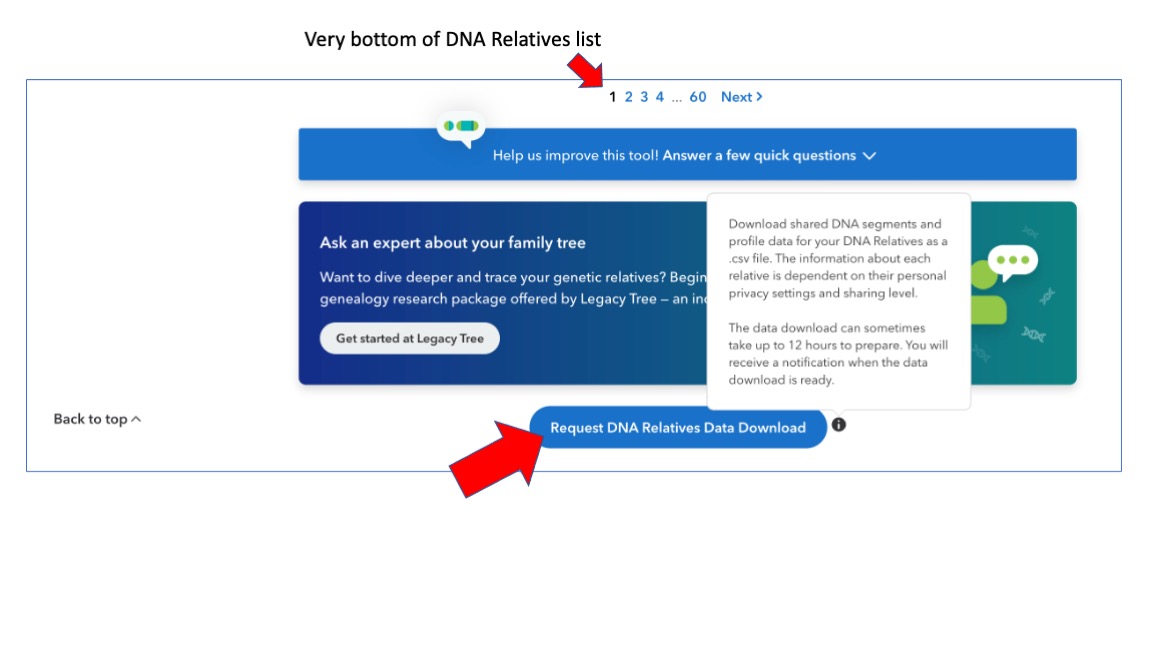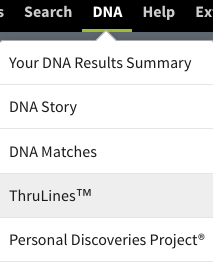Find Genetic Relatives Using DNA
Why Should I Find Genetic Relatives?
Identifying genetic relatives using DNA tests that show your family connections allows you to connect with others who might have your variant. Family history DNA tests can help you find people who share similar stretches of DNA with you, and are thus considered to be your genetic relatives.
Depending on the regions of DNA you share, your genetic relatives could also have the same variant and also have an increased risk for cancer.
How Do I Find Genetic Relatives?
Several companies do DNA testing and provide tools for finding genetic relatives. ConnectMyVariant does not endorse any specific company that provides direct-to-consumer genetic testing or DNA analysis. If you think you might be interested in this testing, Carefully read all consent and privacy policies to be aware of what information you are sharing and how it might be used.
These tests usually do not directly test hereditary disease variants, instead, they look at common genetic variants called single nucleotide polymorphisms (SNPs) that are spread across the whole human genome. Even though they do not directly test for your specific variants, the DNA results can help identify relatives who have the same family-specific risk variant.
These tests use statistical algorithms to look for regions of SNPs that two people have in common – if you do share large regions of DNA with someone, you are likely related to them. All close relatives share at least some DNA with each other. Closer relatives share more DNA on average. We say that there is identity by descent (IBD) for DNA you share with your relatives because you have inherited the same identical stretch of DNA from the same ancestor. If you share the block of DNA surrounding your variant with a relative, it is much more likely that the relative has the same variant as you. The challenge comes when you get to more distantly related individuals because the chances that you share a specific piece of DNA with them get smaller and smaller. SNPs are not good at finding matches once shared DNA segments are too small. If it looks like you don’t share any regions of DNA with someone, you may still be distant cousins or you may not be closely related at all.
Tools offered by various websites allow you to compare DNA across different family members, including yourself.

The picture above displays chromosomes 5 and 6 for multiple genetic relatives. Each chromosome is displayed seven times – one for each relative in the comparison. This example shows the different regions of DNA shared between the relatives; the shared regions are highlighted with a specific color corresponding to a specific relative. With this information, you can easily see which segments of DNA these relatives share.
Suppose you are the first individual in the example above (orange) and have a variant associated with cancer risk that falls within the region of chromosome 5 marked with the red double helix. You can see your relatives colored dark blue, red, and yellow share the same segment of interest on chromosome 5. Therefore, it is possible – though not a guarantee – that these three other relatives could also have the variant.
It is also possible that two people who have inherited a variant from a common ancestor do not appear to share the same region of DNA. This happens if two relatives share a region of DNA that is too small to be detected by these tests (less than about 8 cM). This means that in the example above, the three individuals that do not share the chromosome 5 region (purple, green, and light blue) could still have the variant.
In order to use these tools to get more information about which genetic relatives might have your variant, you must first identify the location of your variant. Once you locate your variant, you can find genetic relatives, and connect with them about possible disease risks. However, people can sometimes share chromosomal segments without sharing the same variant.
What Does Shared DNA Have to Do with Variants?
If you have identified one or more relatives with your variant, you will all share the DNA around that variant as well. Everyone else in your family who has the variant will share the surrounding DNA with everyone else who has the variant. People who do not share the surrounding DNA will not have the variant or will share a segment too small for the SNP algorithms to detect. This is a good way to find out which close relatives do not have your variant, but only gives hints about who might have your variant.
As noted above, people can share a segment of DNA without having the same risk variant. In most cases, if someone shares a segment where your variant is they have about a 50% chance of having your variant. This is because you have two copies of each chromosome, one from your mom and one from your dad. Sometimes it looks like someone shares the same DNA, but they share the copy you inherited from the other parent. If the variant came from your mom, the relative may be sharing the copy of the gene that you got from your dad.
In some cases, a common ancestor lived before the mutation that caused the variant happened. Many people share random segments of DNA from very distant relatives. Everyone is connected if you go back far enough. One should never assume that because someone shares a specific segment, they are guaranteed to have a medically important variant. Knowing about shared DNA increases the chances that you share a variant, but it is always important to recommend confirmatory medical testing if you suspect someone has your variant.

In the example above, Brian and Alejandro share a segment on chromosome 2 between positions 149270710 and 171907571, highlighted in gray. The variant they are interested in is at chr2:160000000. It could be in this shared segment! There are two other relatives who have an overlapping segment (highlighted in blue and green); these two are more likely to share the same variant than people who do not share this segment. Segments can get smaller each generation, so you do not expect them to be exactly the same size. Alejandro and Brian both share the variant and both share DNA with the person highlighted in blue. The person highlighted in blue is ever more likely to have the variant. On the other hand, if the relative with the segment highlighted in green shares this segment with only Brian and not Alejandro, they are unlikely to have the variant that Alejandro and Brian are looking for.
How Do I Locate My Variant?
Find out the genomic location of your variant. Sometimes this is on your report, listed as a chromosome and a long number. If it is not, one way to find genomic location is to look for your variant on ClinVar. You can search ClinVar using any name for your variant, and it will return a chromosome and genomic location.

Note: Use the chromosome location associated with Assembly GRCh37, as this assembly is used most often.
Once you understand your variant’s location, you can look for this location in shared DNA amongst genetic relatives. Remember, if someone looks like they share the segment where your variant is, they have about a 50% chance of having your variant. You have two copies of each gene, and they may be sharing the other copy of the gene.
If someone shares a DNA segment with you and also shares the same segment with other people who you know have your variant, the probability that person has the variant is higher.
Check for Shared DNA with GEDMatch
GEDMatch is a tool that can be used regardless of the company you used for ancestry testing. GEDMatch does not provide testing itself. It was built to collect DNA results from many different sources to help people find each other through shared DNA. This tool requires you to download your raw data and upload it to GEDMatch. For an overview, here is a guide about how genetic matching with DNA SNP kits works.
-
If you have received ancestry genetic data, you can compare your DNA with other people. You both must download your DNA data. Instructions for downloading raw data files can be found at Ancestry, MyHeritage, and 23andMe.
-
Use the "'one-to-one' compare" tool (video tutorial about how to use this tool). Look for matches that span the genomic location of your variant. On the 2D viewer, the numbers on the bottom are in millions of bases, so chr3: 37,042,537 would be on chromosome 3 at about 37M. In general, ignore pink and blue segments, as these are more likely to be background relatedness from very distant relatives.
-
Comparing your DNA with a relative you know has your variant can be useful for tracing your family’s inheritance patterns. If there is a match that is larger than 20 cm at the coordinates of your variant, then it is very likely that you inherited the variant from the same ancestor. This information might help a provider better understand who in your family is at greater risk of inheriting the disease variant.
-
If you want to look for more relatives you can pay $10 and try the one-to-many comparison tool. This allows you to look for anyone in the GEDMatch database who shares a specific segment of DNA.
-
Remember people can share a segment of DNA without having the same risk variant. In most cases, if someone shares a segment where your variant is they have about a 50% chance of having your variant. It is always important to recommend confirmatory medical testing if you suspect someone has your variant.
-
For information about how to interact with genetic relatives, you might identify in this process, read about how to connect with genetic relatives here.
Check for Shared DNA with MyHeritageDNA
-
This will tell you how to find people who might share the segment of DNA with your variant if you have done MyHeritage DNA testing.
-
If you were tested using a different company, like AncestryDNA or 23andMe you may be able to upload your DNA data and find people who have done MyHeritageDNA testing.
-
After you have your DNA data in the MyHeritage system, on the DNA page click “Tools.”
-
One of the tools is “Chromosome Browser.” Select this tool.
-
You will now see a list of all genetic relatives in the MyHeritage system.
-
You can compare your chromosomes to up to seven other relatives. If you share DNA on a chromosome and in a similar location as your variant, there is a 50% chance that this genetic relative inherited your variant.
-
If you already know someone who has your variant and is on MyHeritageDNA, there is another MyHeritageDNA tool you can use to look for others who share a specific DNA location with both of you
-
Click on "DNA Matches" and find the person that you know who shares your variant.
-
Click on the purple "Review DNA Match" button on the right.
-
The next page shows your shared matches. At the right side of each row is a small purple symbol to represent the triangulated matches with that person. Clicking on the symbol opens up another tab that shows you the chromosomes pieces where the three of you matches
-
-
You can also download a list of all DNA matches by hovering over the three dots in the upper right corner of the "DNA matches" table.

For information about how to interact with genetic relatives, you might identify in this process, read about how to connect with genetic relatives here.
Check for Shared DNA with 23andMe
-
This will tell you how to find people who might share the segment of DNA with your variant if you have done 23andMe DNA testing for Ancestry. 23andMe Health is not useful for finding relatives.
-
Before using 23andMe carefully read all consent and privacy policies to be aware of what information you are sharing and how might be used. You will need to decide what to share and opt in to sharing DNA information with relatives.
-
-
After you have your DNA data in the 23andMe system, on the 23andMe ancestry page click “Find your matches” in the DNA Relatives section. For an overview of these tools, please view 23andMe's resources:
-
In the "List" page that shows DNA relatives, select a relative. Below the place where you see your genetic relationship, you can select “View DNA Details”.
-
From there click "Compare with more relatives." You will now see a list of all genetic relatives. You can select several relatives to compare in addition to the initial relative you selected. Make sure to select yourself as one of the relatives.
-
You will get a plot that shows which DNA segments you share with each of these relatives mapped on each of 23 chromosomes. Below the shared segment there are details of the start and end positions of the shared segments.
-
This allows you to compare the genomic position of your shared DNA with the chromosome and location of your variant and see who else shares that segment.
-
To download a full list of people that you share DNA with go to the "List" of DNA relatives and scroll to the bottom, where there is a button to "Request DNA Relatives Data Download." The data download will make it easier to look for all matches.

For information about how to interact with genetic relatives, you might identify in this process, read about how to connect with genetic relatives here.
Check for Shared DNA with AncestryDNA
Ancestry DNA does not have a feature that lets users find out which individual segments of DNA they share with relatives yet. If you want to try this you can download your AncestryDNA raw data file and upload it to GEDMatch or MyHeritageDNA. (See guides to GEDMatch and My Heritage DNA for more instructions about what to do after that).
-
Before using AncestryDNA or other second party analysis services carefully read all consent and privacy policies to be aware of what information you are sharing and how might be used. You will need to decide what to share and opt in to sharing DNA information with relatives.
-
If you want to use AncestryDNA to find relatives with your variant, the information that the ThruLines tool provides about DNA relationships can help.

-
If you already know which parent, grandparent, or great-grandparent had your variant, you can look for others who are descended from the same ancestor.
-
If you know someone else who shares your variant and also has AncestryDNA results, you can find them on ThruLines by looking for a common ancestor. If you click on that person ThruLines will list common relatives that both of you share DNA with. This is not all of your common relatives, just those that you both share some DNA with. However, the people listed on ThruLines could share any DNA segment, not necessarily the DNA segment with your variant.
-
In order to find people that are more likely to have a segment with your variant using ThruLines, you would need to triangulate by comparing ThruLines lists of three or more other relatives who you know have the variant. AncestryDNA does not yet have a segment comparison feature, where you can seek out the location of your variant in this data.
